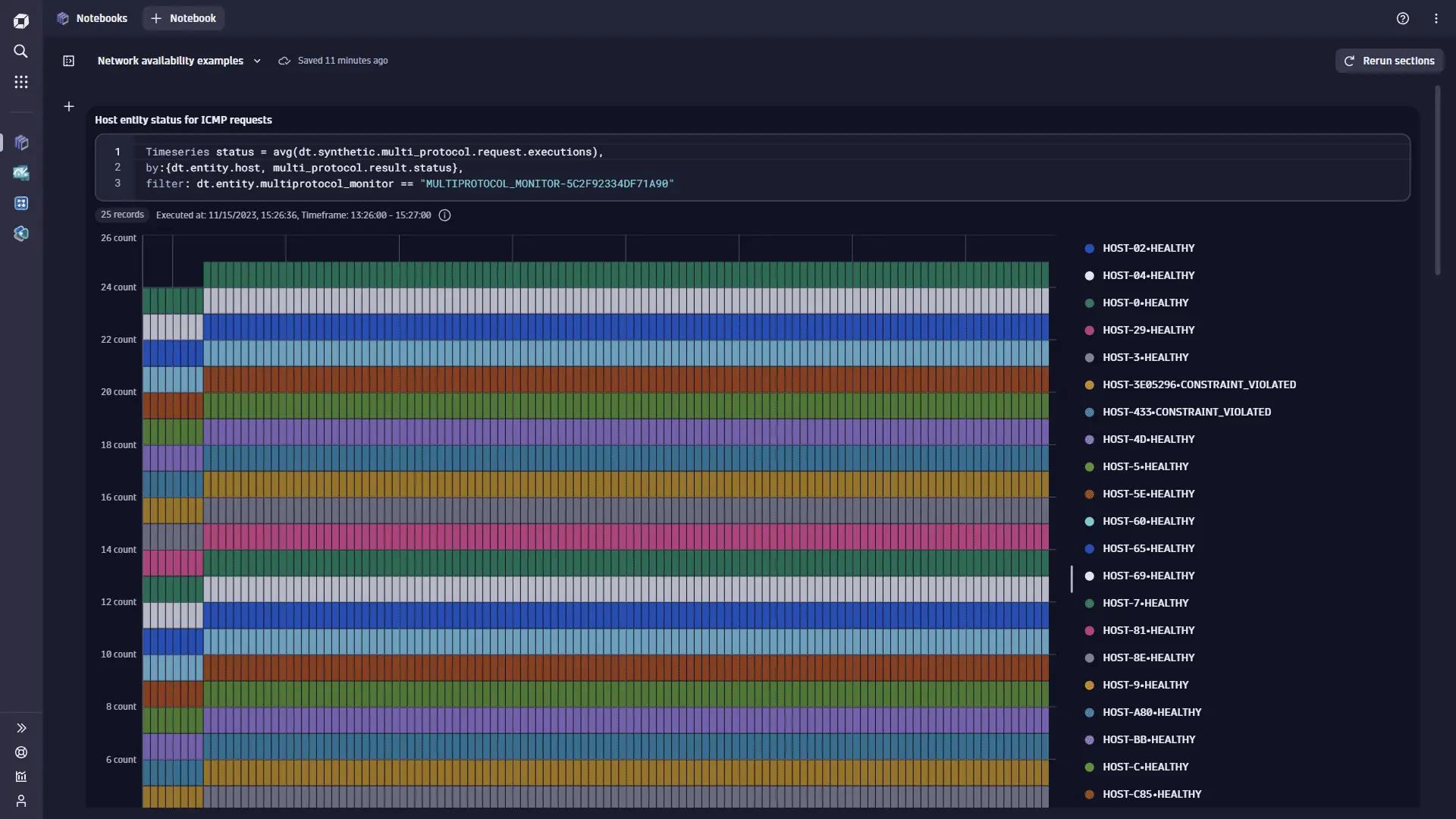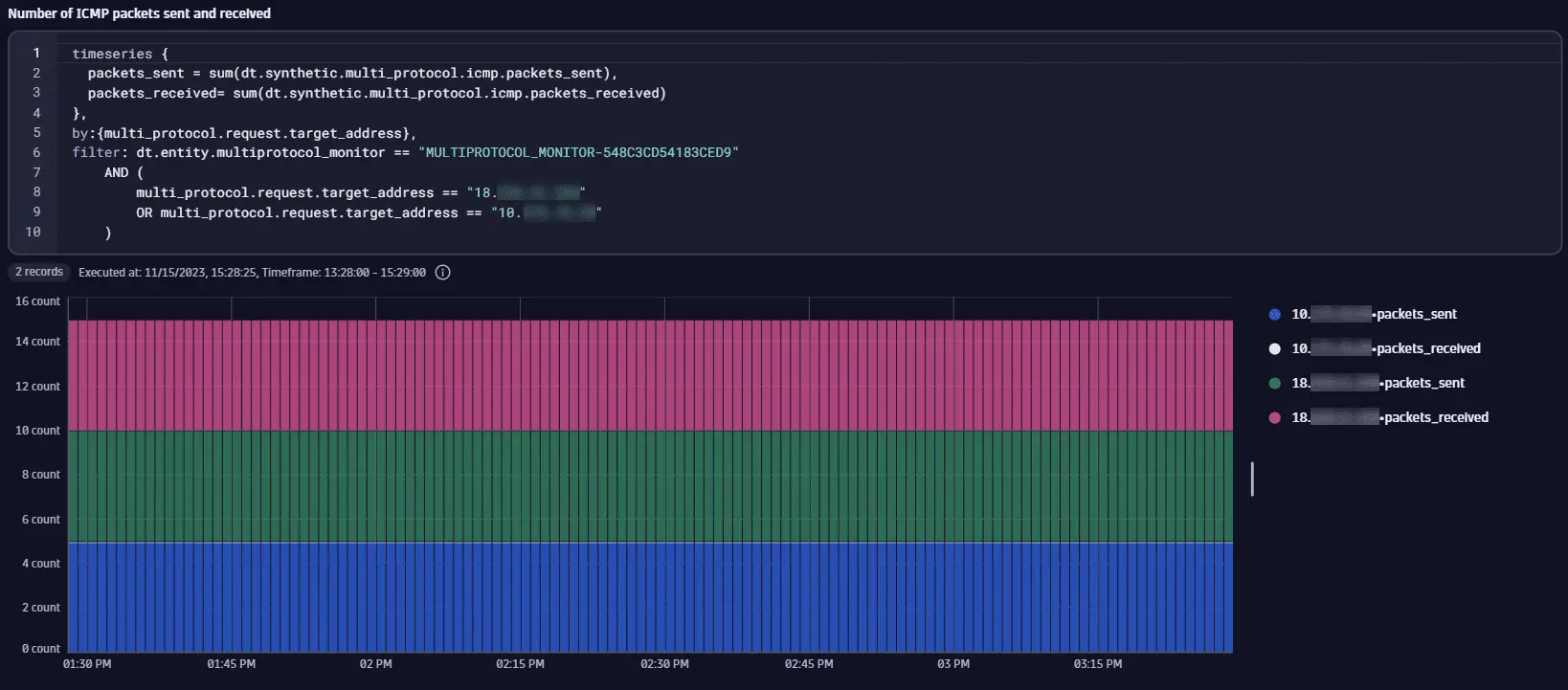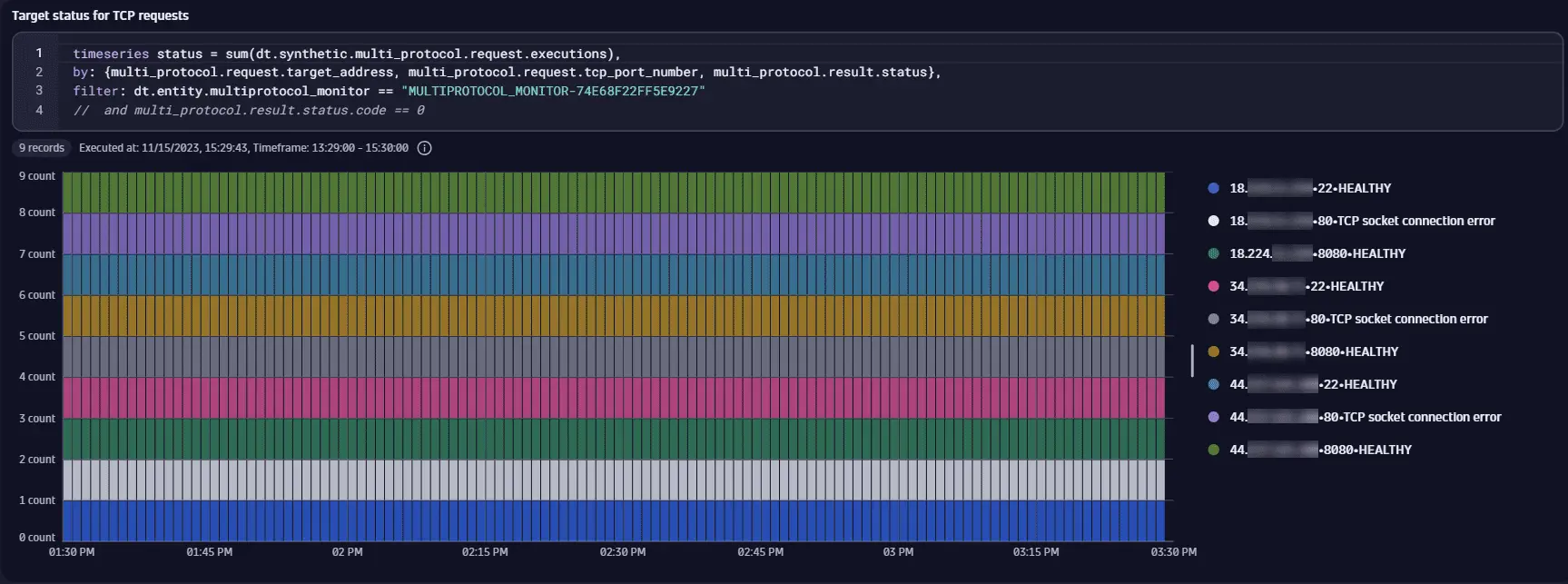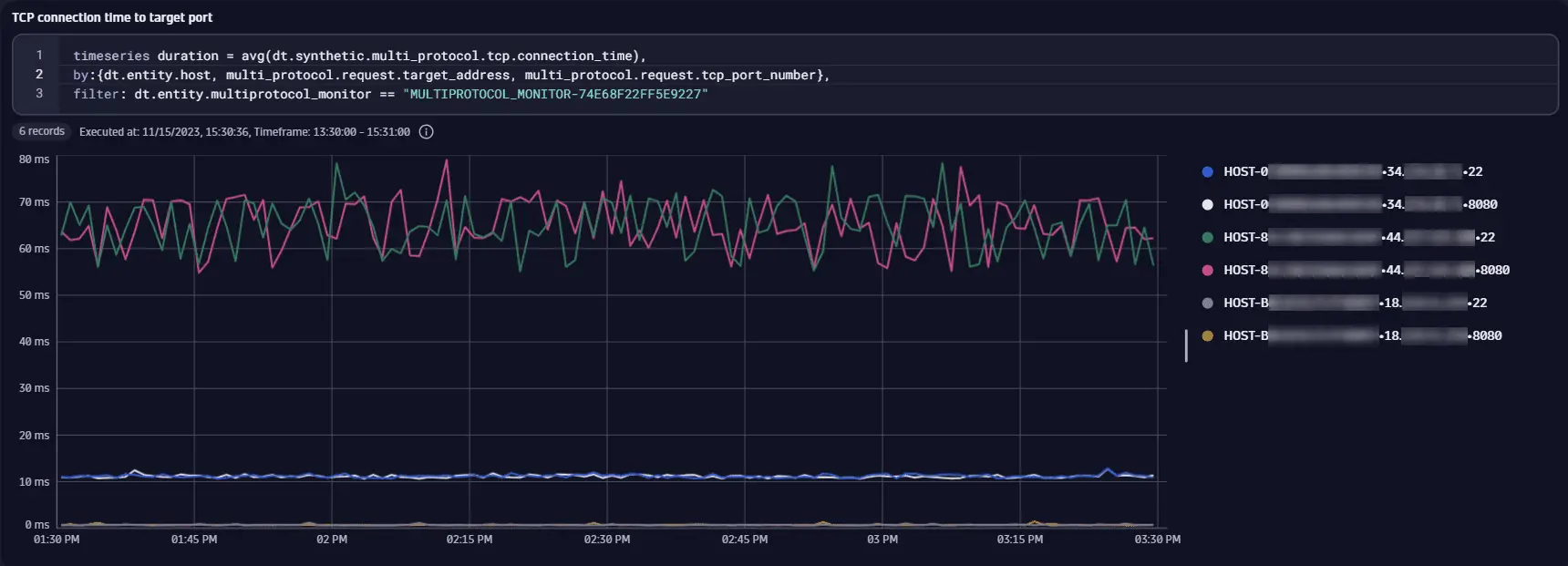NAM monitor metrics
- Latest Dynatrace
- Explanation
- 12-min read
- Published Jun 19, 2024
Metrics and dimensions
Dimensions (all network availability monitors)
| Name | Type | Description | Example value |
|---|---|---|---|
dt.entity.multiprotocol_monitor | string | Monitor ID (monitored entity ID) | MULTIPROTOCOL_MONITOR-3F6C9D500287BBAF |
dt.entity.synthetic_location | string | Synthetic location ID (monitored entity ID) | SYNTHETIC_LOCATION-A4F834D72840EFC1 |
dt.entity.host | string | If available, monitored entity ID for target | HOST-024C103F7F86A290 |
dt.maintenance_window_ids | array | UUIDs of maintenance windows | c715d677-eb1b-3e1b-8dbc-db06cad5b8eb |
dt.synthetic.monitored_entity_ids | array | IDs of monitored entities | APPLICATION-EA7C4B59F27D43EB |
dt.security_context | string | The security context is used in access permissions to limit the visibility | mySecurityContext |
step.id | numeric | Step sequential ID | 1 |
request.id | numeric | Request sequential ID | 2 |
request.type | string | Type of request | icmp, tcp |
request.target_address | string | Address of target entity | 54.171.216.19 |
result.state | string | Result state of monitor execution | SUCCESS, FAIL |
result.status.message | string | Execution status | HEALTHY, CONSTRAINT_VIOLATED |
result.status.code | numeric | Numeric representation of the execution status | 0, 1401 |
interpolated | boolean | Information whether monitor availability was interpolated | false |
multi_protocol.step.id | numeric | Step sequential ID (deprecated, use step.id) | 1 |
multi_protocol.request.id | numeric | Request sequential ID (deprecated, use request.id) | 2 |
multi_protocol.request.type | string | Type of request (deprecated, use request.type) | icmp, tcp |
multi_protocol.request.target_address | string | Address of target entity (deprecated, use request.target_address) | 54.171.216.19 |
multi_protocol.result.state | string | Result state of monitor execution (deprecated, use result.state) | SUCCESS |
multi_protocol.result.status | string | Execution status (deprecated, use result.status.message) | HEALTHY, CONSTRAINT_VIOLATED |
multi_protocol.result.status.code | numeric | Numeric representation of the execution status (deprecated, use result.status.code) | 0, 1401 |
Monitor metrics (all network availability monitors)
| Name | Type | Dimensions | Description |
|---|---|---|---|
dt.synthetic.multi_protocol.availability(latest Dynatrace) builtin:synthetic.multiProtocol.availability(previous Dynatrace) | numeric | dt.entity.multiprotocol_monitordt.entity.synthetic_locationdt.synthetic.monitored_entity_idsdt.security_contextinterpolated | Availability calculated based on the execution status of visits - 100% for code= 0: HEALTHY, SCRIPT_FINISH, SKIPPED- 0% for error status codes such as 1401 - CONSTRAINT_VIOLATED |
dt.synthetic.multi_protocol.execution_time(latest Dynatrace) builtin:synthetic.multiProtocol.executionTime(previous Dynatrace) | numeric | dt.entity.multiprotocol_monitordt.entity.synthetic_locationdt.synthetic.monitored_entity_idsdt.security_context | Duration between start and end time of visit execution (in milliseconds) Metric available only if visit execution took place; both start time and end time must be available. |
dt.synthetic.multi_protocol.executions(latest Dynatrace) builtin:synthetic.multiProtocol.executions(previous Dynatrace) | numeric | dt.entity.multiprotocol_monitordt.entity.synthetic_locationdt.synthetic.monitored_entity_idsdt.security_contextdt.maintenance_window_idsresult.stateresult.status.coderesult.status.messagemulti_protocol.result.state (deprecated, use result.state)multi_protocol.result.status.code(deprecated, use result.status.code)multi_protocol.result.status (deprecated, use result.status.message) | Number of monitor executions in time |
dt.synthetic.multi_protocol.success_rate(latest Dynatrace) builtin:synthetic.multiProtocol.successRate(previous Dynatrace) | numeric | dt.entity.multiprotocol_monitordt.entity.synthetic_locationdt.synthetic.monitored_entity_idsdt.security_context | Ratio of executed steps that didn't fail (successes + skips) to all executed steps We take into account steps that were actually executed rather than steps intended to be executed. For example, with 2 successful steps, 1 failed step, and 8 not started, the ratio is 2/3, or 66.67%. |
Step metrics (all network availability monitors)
| Name | Type | Dimensions | Description |
|---|---|---|---|
dt.synthetic.multi_protocol.step.availability(latest Dynatrace) builtin:synthetic.multiProtocol.step.availability(previous Dynatrace) | numeric | dt.entity.multiprotocol_monitordt.entity.synthetic_locationdt.synthetic.monitored_entity_idsdt.security_contextstep.idrequest.typemulti_protocol.step.id (deprecated, use step.id)multi_protocol.request.type (deprecated, use request.type) | Availability calculated based on the execution status of steps - 100% for code= 0: HEALTHY, SCRIPT_FINISH, SKIPPED- 0% for error status codes such as 1401 - CONSTRAINT_VIOLATED |
dt.synthetic.multi_protocol.step.execution_time(latest Dynatrace) builtin:synthetic.multiProtocol.step.executionTime(previous Dynatrace) | numeric | dt.entity.multiprotocol_monitordt.entity.synthetic_locationdt.synthetic.monitored_entity_idsdt.security_contextstep.idrequest.typemulti_protocol.step.id (deprecated, use step.id)multi_protocol.request.type (deprecated, use request.type) | Duration between start and end time of step execution (in milliseconds) Metric available only if step execution took place, with a well-defined end time; therefore, it's not available for skipped steps. |
dt.synthetic.multi_protocol.step.executions(latest Dynatrace) builtin:synthetic.multiProtocol.step.executions(previous Dynatrace) | numeric | dt.entity.multiprotocol_monitordt.entity.synthetic_locationdt.synthetic.monitored_entity_idsdt.security_contextstep.idrequest.typeresult.stateresult.status.coderesult.status.messagemulti_protocol.step.id (deprecated, use step.id)multi_protocol.request.type (deprecated, use request.type)multi_protocol.result.state (deprecated, use result.state)multi_protocol.result.status (deprecated, use result.status.message)multi_protocol.result.status.code(deprecated, use result.status.code) | Number of step executions in time |
dt.synthetic.multi_protocol.step.success_rate(latest Dynatrace) builtin:synthetic.multiProtocol.step.successRate(previous Dynatrace) | numeric | dt.entity.multiprotocol_monitordt.entity.synthetic_locationdt.synthetic.monitored_entity_idsdt.security_contextstep.idrequest.typemulti_protocol.step.id (deprecated, use step.id)multi_protocol.request.type (deprecated, use request.type) | Ratio of executed requests that didn't fail to all executed requests. If a step doesn't have executed requests (because nothing matches its definition in a monitor configuration), we return the value 100%. For example, with 2 successful requests and 1 failed request, the ratio is 2/3, or 66.67%. |
Request metrics (all network availability monitors)
| Name | Type | Dimensions | Description |
|---|---|---|---|
dt.synthetic.multi_protocol.request.availability(latest Dynatrace) builtin:synthetic.multiProtocol.request.availability(previous Dynatrace) | numeric | dt.entity.multiprotocol_monitordt.entity.synthetic_locationdt.entity.host (only for monitors with filter defined)dt.synthetic.monitored_entity_idsdt.security_contextstep.idrequest.idrequest.target.addressrequest.typemulti_protocol.step.id (deprecated, use step.id)multi_protocol.request.id (deprecated, use request.id)multi_protocol.request.target_address (deprecated, use request.target.address)multi_protocol.request.type (deprecated, use request.type) | Availability calculated based on the execution status of requests - 100% for code= 0: HEALTHY, SCRIPT_FINISH, SKIPPED- 0% for error status codes such as 1401 - CONSTRAINT_VIOLATED |
dt.synthetic.multi_protocol.request.executions(latest Dynatrace) builtin:synthetic.multiProtocol.request.executions(previous Dynatrace) | numeric | dt.entity.multiprotocol_monitordt.entity.synthetic_locationdt.entity.host (only for monitors with filter defined)dt.synthetic.monitored_entity_idsdt.security_contextstep.idrequest.idrequest.target.addressrequest.typeresult.stateresult.status.coderesult.status.messagemulti_protocol.step.id (deprecated, use step.id)multi_protocol.request.id (deprecated, use request.id)multi_protocol.request.target_address (deprecated, use request.target.address)multi_protocol.request.type (deprecated, use request.type)multi_protocol.result.state (deprecated, use result.state)multi_protocol.result.status (deprecated, use result.status.message)multi_protocol.result.status.code(deprecated, use result.status.code) | Number of request executions in time |
ICMP monitor metrics
| Name | Type | Dimensions | Description |
|---|---|---|---|
dt.synthetic.multi_protocol.icmp.success_rate(latest Dynatrace) builtin:synthetic.multiProtocol.icmp.successRate(previous Dynatrace) | numeric | dt.entity.multiprotocol_monitordt.entity.synthetic_locationdt.entity.host (only for monitors with filter defined)dt.security_contextstep.idrequest.idrequest.target.addressrequest.typemulti_protocol.step.id (deprecated, use step.id)multi_protocol.request.id (deprecated, use request.id)multi_protocol.request.target_address (deprecated, use request.target.address)multi_protocol.request.type (deprecated, use request.type) | Ratio of received packets to sent packets Doesn't take into account the configured number of packets to be sent. For example, out of 10 packets to be sent, if 5 were sent and 4 were received, the ratio is 4/5, or 80.00%. |
dt.synthetic.multi_protocol.icmp.packets_sent(latest Dynatrace) builtin:synthetic.multiProtocol.icmp.packetsSent(previous Dynatrace) | numeric | dt.entity.multiprotocol_monitordt.entity.synthetic_locationdt.entity.host (only for monitors with filter defined)dt.security_contextstep.idrequest.idrequest.target.addressrequest.typemulti_protocol.step.id (deprecated, use step.id)multi_protocol.request.id (deprecated, use request.id)multi_protocol.request.target_address (deprecated, use request.target.address)multi_protocol.request.type (deprecated, use request.type) | Total number of packets sent |
dt.synthetic.multi_protocol.icmp.packets_received(latest Dynatrace) builtin:synthetic.multiProtocol.icmp.packetsReceived(previous Dynatrace) | numeric | dt.entity.multiprotocol_monitordt.entity.synthetic_locationdt.entity.host (only for monitors with filter defined)dt.security_contextstep.idrequest.idrequest.target.addressrequest.typemulti_protocol.step.id (deprecated, use step.id)multi_protocol.request.id (deprecated, use request.id)multi_protocol.request.target_address (deprecated, use request.target.address)multi_protocol.request.type (deprecated, use request.type) | Number of packets that were returned successfully |
dt.synthetic.multi_protocol.icmp.round_trip_time(latest Dynatrace) builtin:synthetic.multiProtocol.icmp.roundTripTime(previous Dynatrace) | numeric | dt.entity.multiprotocol_monitordt.entity.synthetic_locationdt.entity.host (only for monitors with filter defined)dt.security_contextstep.idrequest.idrequest.target.addressrequest.typemulti_protocol.step.id (deprecated, use step.id)multi_protocol.request.id (deprecated, use request.id)multi_protocol.request.target_address (deprecated, use request.target.address)multi_protocol.request.type (deprecated, use request.type) | Round-Trip Time for received packets |
dt.synthetic.multi_protocol.icmp.request_execution_time(latest Dynatrace) builtin:synthetic.multiProtocol.icmp.requestExecutionTime(previous Dynatrace) | numeric | dt.entity.multiprotocol_monitordt.entity.synthetic_locationdt.entity.host (only for monitors with filter defined)dt.security_contextstep.idrequest.idrequest.target.addressrequest.typemulti_protocol.step.id (deprecated, use step.id)multi_protocol.request.id (deprecated, use request.id)multi_protocol.request.target_address (deprecated, use request.target.address)multi_protocol.request.type (deprecated, use request.type) | Duration between start and end time of request handling (in milliseconds) This metric is always provided, even if actual request execution did not take place (for example, because of exceptions or timeouts). Diagnostic metric—allows for validation of external ping process execution time. |
TCP monitor dimensions
| Name | Type | Description | Example value |
|---|---|---|---|
request.tcp_port_number | string | TCP request port number, as provided in monitor configuration | 665 |
multi_protocol.request.tcp_port_number | string | TCP request port number, as provided in monitor configuration (deprecated, use request.tcp_port_number) | 665 |
TCP monitor metrics
| Name | Type | Dimensions | Description |
|---|---|---|---|
dt.synthetic.multi_protocol.tcp.connection_time(latest Dynatrace) builtin:synthetic.multiProtocol.tcp.connectionTime(previous Dynatrace) | numeric | dt.entity.multiprotocol_monitordt.entity.synthetic_locationdt.entity.host (only for monitors with filter defined)dt.security_contextstep.idrequest.idrequest.target.addressrequest.typemulti_protocol.step.id (deprecated, use step.id)multi_protocol.request.id (deprecated, use request.id)multi_protocol.request.target_address (deprecated, use request.target.address)multi_protocol.request.type (deprecated, use request.type)request.tcp_port_numbermulti_protocol.request.tcp_port_number (deprecated, use: request.tcp_port_number) | Duration between start time (socket creation and connection) and end time (when confection is successfully established) in milliseconds Metric available only if request execution took place (with no exceptions or timeouts), with a well-defined end time |
DNS monitor dimensions
| Name | Type | Description | Example value |
|---|---|---|---|
request.dns_record_type | string | DNS record type to be queried by request, as provided in configuration | A, AAAA, CNAME |
multi_protocol.request.dns_record_type | string | DNS record type to be queried by request, as provided in configuration (deprecated, use request.dns_record_type) | A, AAAA, CNAME |
DNS monitor metrics
| Name | Type | Dimensions | Description |
|---|---|---|---|
dt.synthetic.multi_protocol.dns.resolution_time(latest Dynatrace) builtin:synthetic.multiProtocol.dns.resolutionTime(previous Dynatrace) | numeric | dt.entity.multiprotocol_monitordt.entity.synthetic_locationdt.entity.host (only for monitors with filter defined)dt.security_contextstep.idrequest.idrequest.target.addressrequest.typemulti_protocol.step.id (deprecated, use step.id)multi_protocol.request.id (deprecated, use request.id)multi_protocol.request.target_address (deprecated, use request.target.address)multi_protocol.request.type (deprecated, use request.type)request.dns_record_typemulti_protocol.request.dns_record_type (deprecated, use: request.dns_record_type) | Duration between start and end time of the request to the DNS server, in milliseconds Metric available only if request execution took place (with no exceptions or timeouts), with a well-defined end time |
DQL queries to extract data
Use DQL queries to extract data with metrics and dimensions.
The following examples use Notebooks  to demonstrate how to work with the results of network availability monitors. They use result metrics as a starting point to explore possibilities of extracting and interpreting data with DQL.
to demonstrate how to work with the results of network availability monitors. They use result metrics as a starting point to explore possibilities of extracting and interpreting data with DQL.
Host entity status for ICMP requests
The monitor MULTIPROTOCOL_MONITOR-5C2F92334DF71A90 executes ICMP requests and filters monitored hosts with "targetFilter": "hostGroup == e2e-synthetic-private-location" (which resolves to about 26 hosts).
By using the dt.synthetic.multi_protocol.request.executions metric and splitting it by the dt.entity.host and result.status.message dimensions, we can display the status of the connection to a particular monitored host entity in this host group. Some hosts do not fulfill the expected success rate; instead of being HEALTHY, their requests are marked as CONSTRAINT_VIOLATED.
Timeseries status = avg(dt.synthetic.multi_protocol.request.executions),by:{dt.entity.host, result.status.message},filter: dt.entity.multiprotocol_monitor == "MULTIPROTOCOL_MONITOR-5C2F92334DF71A90"

Number of ICMP packets sent and received
The monitor MULTIPROTOCOL_MONITOR-548C3CD54183CED9 executes ICMP requests to hosts with the explicitly defined IP addresses, 18.x.x.x, 10.x.x.x, and 34.x.x.x. Each of these IP addresses maps to a distinct host.
We use the sum of the dt.synthetic.multi_protocol.icmp.packets_sent and the sum of the dt.synthetic.multi_protocol.icmp.packets_received metrics to get insight into how many packets were sent and received.
We split results by the request.target_address dimension and filter data for 18.x.x.x and 10.x.x.x only.
For 18.x.x.x, the same number of packets were received as were sent, but for 10.x.x.x, all packets are lost and none were received.
timeseries {packets_sent = sum(dt.synthetic.multi_protocol.icmp.packets_sent),packets_received= sum(dt.synthetic.multi_protocol.icmp.packets_received)},by:{request.target_address},filter: dt.entity.multiprotocol_monitor == "MULTIPROTOCOL_MONITOR-548C3CD54183CED9"AND (request.target_address == "18.x.x.x"OR request.target_address == "10.x.x.x")

Target status for TCP requests
The monitor MULTIPROTOCOL_MONITOR-74E68F22FF5E9227 executes TCP requests to hosts from a host group that resolves to the IP addresses 18.x.x.x, 34.x.x.x, and 44.x.x.x.
To display the status of the TCP connection for an IP-port pair, we use the dt.synthetic.multi_protocol.request.executions metric and splitting it by the dimensions:
request.target_addressrequest.tcp_port_numberresult.status.message
In this example:
- Each host has the ports
22(SSH) and8080(HTTP server) open, and each connection to the hosts on these ports succeeds with theHEALTHYstatus. - No service uses the standard HTTP port
80. Therefore, connections to all hosts on that port fail with theTCP socket connection errorstatus.
Note that results of this query can be limited to just successful requests by filtering by the multi_protocol.result.status.code dimension (code == 0).
timeseries status = sum(dt.synthetic.multi_protocol.request.executions),by: {request.target_address, request.tcp_port_number, result.status.message},filter: dt.entity.multiprotocol_monitor == "MULTIPROTOCOL_MONITOR-74E68F22FF5E9227"// and result.status.code == 0

TCP connection time to target port
The monitor MULTIPROTOCOL_MONITOR-74E68F22FF5E9227 executes TCP requests to hosts from a host group that resolves to the IP addresses 18.x.x.x, 34.x.x.x, and 44.x.x.x.
In this example, instead of IP addresses, we split the results by monitored host entity IDs.
To check typical time taken for a successful connection to the target port for a host, we use the average of the dt.synthetic.multi_protocol.tcp.connection_time metric split by the dimensions:
dt.entity.hostrequest.target_addressrequest.tcp_port_number
Only ports 22 (SSH) and 8080 (HTTP server) are open, and these are the only ports for which dt.synthetic.multi_protocol.tcp.connection_time is available. The hosts are effectively in different geographical locations (Ohio, Oregon, and North Virginia in the United States), so a difference in connection times is expected.
timeseries duration = avg(dt.synthetic.multi_protocol.tcp.connection_time),by:{dt.entity.host, request.target_address, request.tcp_port_number},filter: dt.entity.multiprotocol_monitor == "MULTIPROTOCOL_MONITOR-74E68F22FF5E9227"

Execution statuses
All network availability monitors
| Code / message | Example | Description |
|---|---|---|
0 HEALTHY | - | All is well. |
-1 UNEXPECTED_ERROR | Resource saturation | Unexpected problem that's usually related to monitor's execution components. |
1401 CONSTRAINT_VIOLATED | - | Constraint conditions that were defined in monitor's configuration were not met. |
1604 VALIDATION_ERROR | - | Improper monitor configuration detected. |
12013 UNKNOWN_HOST | Error in the hostname | IP address of the host cannot be determined. Possible causes: - Invalid hostname - DNS server unreachable - DNS cache issues - Firewall or proxy interference |
12033 Execution timeout | Server operates slowly. | Timeout of request execution. Possible causes: - Network issues - Slow or unresponsive server or service - Connection blocked by firewall rules - Timeout is too small. |
TCP monitor execution statuses
| Code / message | Example | Description |
|---|---|---|
22000 TCP socket connection error | Service is not listening on a specified port. | This status means that the host was identified and available but the TCP connection could not be established or was unexpectedly closed. Additional explanation for the exact exception is provided. The status is used if a java.net.SocketException is thrown during the connection attempt. Possible causes:- Service is not listening on the specified port. - Service reached resource or connection limit. - Service became unavailable during the socket connection process. |